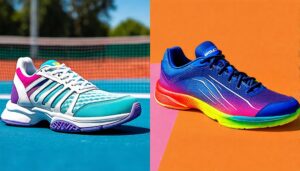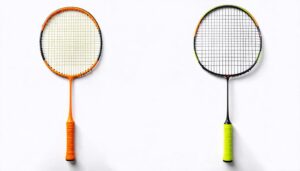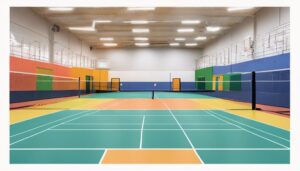When choosing between pickleball shoes and tennis shoes, consider their specialized features. Pickleball shoes prioritize quick lateral movements and have flexible soles for agility, while tennis shoes focus on stability with more rigid soles suited for longer, linear motions. Pickleball shoes use responsive cushioning for sharper turns, whereas tennis shoes offer enhanced midsole support for extended play. Traction differs too; pickleball shoes have a herringbone tread designed for multidirectional grip, while tennis shoes are tailored for specific surface types. Understand the key differences, and you might find the perfect fit for your game.
Key Features of Pickleball Shoes
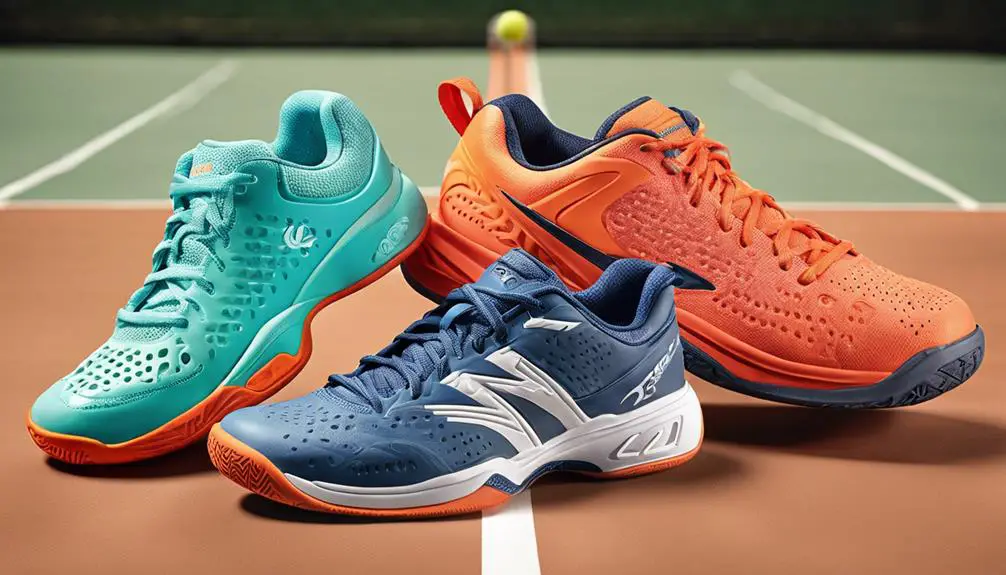
When it comes to choosing the right footwear for pickleball, understanding the key features of pickleball shoes can make all the difference. Unlike traditional tennis shoes, pickleball shoes are specifically designed to meet the demands of quick lateral movements and sudden stops. One of the most critical aspects is the use of breathable materials. These fabrics allow for better airflow, keeping your feet cool and dry during intense games. This breathability is essential, as it helps prevent discomfort and blisters, allowing you the freedom to focus solely on your performance.
Another key feature to take into account is cushioning technology. Pickleball involves a lot of jumping and rapid footwork, so you need shoes that provide ample support and shock absorption. Look for shoes that incorporate advanced cushioning systems which not only enhance comfort but also reduce the impact on your joints. This is particularly important if you plan to play for extended periods.
When comparing pickleball shoes to tennis shoes, it’s evident that pickleball footwear is built with specific agility and stability in mind. While tennis shoes may excel on the baseline, they often lack the specialized support needed for the fast-paced, side-to-side movements found in pickleball. Ultimately, investing in shoes that feature breathable materials and effective cushioning technology can elevate your game and keep you feeling light on your feet. Choose wisely, and you’ll enjoy the freedom to play at your best!
Essential Characteristics of Tennis Shoes
Tennis shoes are engineered with specific characteristics that cater to the demands of the sport, ensuring peak performance on the court. When you choose a pair, you’ll notice a few vital features that set them apart from other athletic footwear, particularly regarding shoe materials and cushioning technology. Here are four significant characteristics to take into account:
- Durable Shoe Materials: Tennis shoes are often constructed from robust materials like synthetic leather and mesh, providing both durability and breathability. This combination helps in maintaining foot health during intense matches.
- Enhanced Cushioning Technology: The right cushioning system is essential for shock absorption and comfort. Many tennis shoes incorporate advanced cushioning technologies, such as EVA foam or gel inserts, which reduce impact on your joints during lateral movements.
- Supportive Structure: A good tennis shoe features a supportive midsole that stabilizes your foot during quick side-to-side movements. This support minimizes the risk of injuries and enhances your overall agility on the court.
- Non-Slip Outsole: Tennis shoes are designed with outsoles that offer excellent traction on various court surfaces, ensuring you won’t easily slip or lose your footing while chasing down the ball.
Understanding these vital characteristics can help you make an informed choice when selecting tennis shoes. They’re not just about style; they’re built to elevate your game and keep you comfortable while you play.
Differences in Sole Design
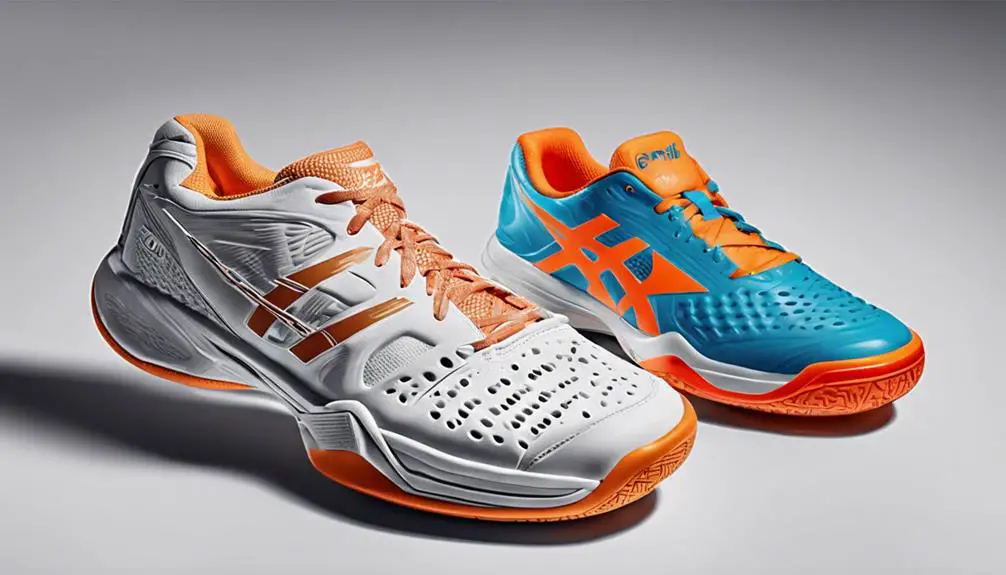
A key distinction between pickleball shoes and tennis shoes lies in their sole design, which directly impacts performance on the court. When you’re playing pickleball, you need a shoe that allows for quick lateral movements and rapid directional changes. Pickleball shoes typically feature a sole designed for enhanced sole flexibility, allowing your foot to move naturally during those fast-paced rallies. This flexibility is essential for executing swift, agile movements that pickleball demands.
In contrast, tennis shoes are constructed with a more rigid sole, providing the support needed for longer, more linear movements that are characteristic of tennis. The soles on tennis shoes often include a herringbone or modified pattern that’s tailored for the specific surface of tennis courts, whether they’re hard, clay, or grass. This pattern helps with traction but can limit the ankle’s range of motion compared to the more forgiving soles of pickleball shoes.
Cushioning technology also varies greatly between the two types of footwear. Pickleball shoes often incorporate responsive cushioning that absorbs shock while allowing for rapid shifts. This is essential for reducing fatigue during intense matches. On the other hand, tennis shoes typically have a firmer midsole to support longer play sessions, which can lead to a less dynamic feel when quick footwork is required.
Ultimately, selecting the right shoe based on sole design can enhance your performance and enjoyment of the game.
Support and Stability Needs
The differences in sole design between pickleball and tennis shoes also reflect varying support and stability needs during play. When you’re on the court, it’s essential to understand how these shoes cater to your body’s requirements, particularly regarding ankle support and lateral stability.
Pickleball involves quick lateral movements and sudden stops, which means you need shoes that offer enhanced lateral stability. Tennis, while also dynamic, generally allows for more linear movement, thereby requiring different support characteristics. Here’s a breakdown of the key support and stability features to take into account:
- Ankle Support: Pickleball shoes often feature a higher cut to provide additional ankle support, reducing the risk of sprains during abrupt lateral shifts.
- Cushioning: Tennis shoes usually have more cushioning for the vertical impacts associated with serves and volleys, helping absorb shock.
- Stability Features: Look for shoes with reinforced sides in pickleball options to prevent foot roll during agile movements, whereas tennis shoes may prioritize overall arch support.
- Weight Distribution: Tennis shoes are generally designed to balance weight distribution over longer periods, while pickleball shoes emphasize quick responsiveness and agility.
Traction Requirements for Each Sport
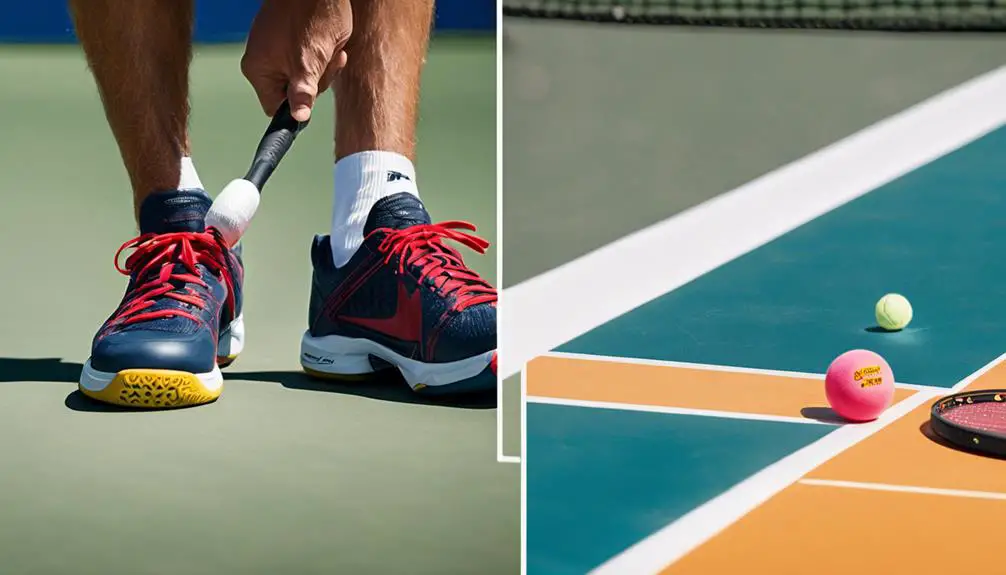
When it comes to court sports, traction plays an important role in performance and safety. In pickleball, the primary court surface is often a smooth, indoor or outdoor material, which requires shoes with a specific grip to prevent slipping during quick lateral movements. The shoe’s sole should provide a good balance of traction without being overly sticky, allowing you to slide slightly when needed while still maintaining control. A herringbone tread pattern is ideal, as it offers multidirectional grip suitable for the fast-paced action of pickleball.
On the other hand, tennis courts can vary between hard, clay, and grass surfaces, each demanding different traction needs. For hard courts, you’ll find that shoes designed for this environment often feature a more durable rubber compound that grips the surface firmly, allowing for explosive lateral movement and quick stops. The tread patterns are typically more aggressive to guarantee stability during powerful serves and volleys.
When playing on clay, however, you’ll want shoes designed with a more specialized sole that helps you slide easily while still providing traction. This is vital for executing those sharp angles and sudden direction changes that are part of the game.
Choosing the Right Footwear
Selecting the right footwear for pickleball or tennis is essential for optimizing performance and preventing injury. The choice of shoes can greatly impact your game, and understanding your foot type and the playing surface is critical. Both sports demand different features in footwear, so it’s important to know what suits your needs.
Here’s a quick guide to help you choose the right footwear:
- Foot Type: Identify whether you have flat, neutral, or high-arched feet. Each foot type benefits from different levels of support and cushioning.
- Playing Surface: Consider the court surface you’ll be playing on. Outdoor surfaces may require shoes with more durability, while indoor courts may benefit from softer soles for better grip.
- Traction Needs: Look for shoes that provide adequate traction based on your playing style. Pickleball often involves quick lateral movements, so shoes with a non-marking sole are preferred.
- Comfort and Fit: Verify that the shoes fit well and feel comfortable. A snug fit without being tight will help you maintain agility on the court.
Frequently Asked Questions
Can I Use Tennis Shoes for Playing Pickleball?
You can use tennis shoes on a pickleball court, but be cautious. They might lack proper shoe traction for quick lateral movements, which could affect your performance and increase the risk of slipping during play.
What Are the Best Brands for Pickleball Shoes?
When selecting the best brands for pickleball shoes, consider options like ASICS and New Balance. They’re known for their shoe durability and traction performance, ensuring you’ve got the support and grip needed for dynamic play.
How Often Should I Replace My Pickleball Shoes?
Think of your shoes as your foundation. To maintain ideal performance, replace them every 6-12 months. A worn shoe’s lifespan can greatly impact your game, leading to reduced stability and potential injuries. Don’t compromise your freedom!
Are There Specific Shoe Sizes for Pickleball Players?
When considering pickleball shoe sizing, it’s essential to focus on a proper shoe fit. A well-fitted shoe enhances performance and reduces injury risk, allowing you to move freely and confidently on the court.
Do Pickleball Shoes Come in Different Widths?
Yes, pickleball shoes come in different widths. Their features cater to various court surfaces, enhancing grip and stability. Choosing the right width guarantees comfort and performance, allowing you to move freely during your game.


